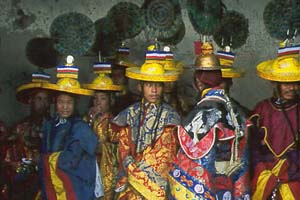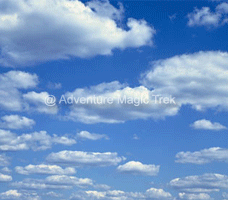
24 Hours Support Call
+977-9841570317 (Shankar Pandey)
email:info@adventurehikenepal.com
Tiji Festival, Mustang
Tiji Festival
 The Tiji festival is a three-day ritual known as "The chasing of the Demons" that centers on the Tiji myth. The myth tells of a deity named Dorje Jono who must battle against his demon father to save the Kingdom of Mustang from destruction. The demon father wreaked havoc on Mustang by bringing a shortage of water (a highly precious resource in this very dry land) and causing many resulting disasters from famine to animal loss. Dorje Jono eventually beats the demon and banishes him from the land. Tiji is a celebration and reaffirmation of this myth and throughout the festival the various scenes of the myth will be enacted. It is of course timed to coincide with the end of the dry winter/spring season and will usher in the wetter monsoon season (the growing season for Mustang). Tiji comes from the word "ten che" meaing ‘the hope of Buddha Dharma prevailing in all worlds' and is effectively a spring renewal festival.
The Tiji festival is a three-day ritual known as "The chasing of the Demons" that centers on the Tiji myth. The myth tells of a deity named Dorje Jono who must battle against his demon father to save the Kingdom of Mustang from destruction. The demon father wreaked havoc on Mustang by bringing a shortage of water (a highly precious resource in this very dry land) and causing many resulting disasters from famine to animal loss. Dorje Jono eventually beats the demon and banishes him from the land. Tiji is a celebration and reaffirmation of this myth and throughout the festival the various scenes of the myth will be enacted. It is of course timed to coincide with the end of the dry winter/spring season and will usher in the wetter monsoon season (the growing season for Mustang). Tiji comes from the word "ten che" meaing ‘the hope of Buddha Dharma prevailing in all worlds' and is effectively a spring renewal festival.
Three Days in TIJI Festival
Early in the afternoon, horns resounded, announcing the two twelve-foot copper dunchens, with their elephantine blurting, followed by two double-reeled horns, all accompanied by drum and cymbals.Next, an ancient and enormous tanka three stories high was unrolled down the entire south wall of the square. The thanka portrayed Padma Sambhava or (Guru Rimpoche) who brought this ceremony to Tibet in the 8th century."
At mid-afternoon, in high wind and blowing dust, eleven lamas in maroon and gold, wearing high red hats, came from the palace and took their places along the wall beneath the thanka, with Tashi Tenzing on the elevated seat just in the center.As the monks and lamas commence chanting, twelve more monks come from the palace in maroon and royal blue and glittering gold brocade, with cymbal-shaped hats decked with upright peacock plumes. Soon they withdraw, to be replaced by the masked dancers who" start the portrayal of the Tiji myth.Dorje Jono repels the demon through the power of his magical dancing — he dances fifty-two separate dances, one of them in ten different bodies, each with a different head. As the dances end, Dorje Jono kills the demon, after which his people are relieved of their plague of misfortunes, water becomes plentiful once more, and the balance and harmony of existence are restored.
On the second day of Tiji, numbers of Loba have arrived from the outlying hamlets, and the small square is thronged with wild beautiful people, with all of the women and children, at least, in traditional dress.The King of Mustang, "wears a whole crown of tiny river pearls set off by dozens of large red coralline tones interspersed with matched ornaments of turquoise.The costumes and masks, the twelve-foot horns, the gold cups of wheat, the butter cakes, the snow peaks and wind and dust and sun, the mehti, snow leopard, snow pigeons, saligrams, the dying glacier and the desert ruins, the drunks and rajas and foreigners, the dogs and yaks. Tantra!
On the third day, Tiji ends with the ceremonial destruction of the evil remains, represented by some long black yak hair and red torma cakes minced to a dark red gurry. The demons red remnants are set out on an old tiger skin, where-upon they are attacked by bow and arrow, slings, and the old guns. The poor devils remains are over- turned upon the ground, each time to a wild cannonade from the old muzzle-loaders and a wave of cheers and smoke.
Itinerary:
Day 01 : Arrival at Kathmandu and transfer to Hotel.
Day 02 : Preparation for trekking/ Sightseeing o/n at hotel.
Day 03 : (Kathmandu/Pokhara) Fly to Pokhara and overnight at Pokhara hotel.
Day 04 : (Pokhara/Jomosom) Early flight to Jomosom and trek to Kagbeni. This day is an easy day hike to Kagbeni along the Kaligandaki river. Today there is not much of climb up and down mostly gradual up to Kagbeni.
Day 05 : (Kagbeni/Chele) The trail takes you up the east bank of Kali Gandagi that climbs over many ridges as it heads north. In the dry season, it is possible to trek the entire route up the river along the sand and gravel of the riverbed.
Day 06 : (Chele/Geling) The climb from Chele is up a steep spur to a cairn at 3130 metres. Here there is view of the village of Gyagar across a huge canyon. A long wall of packed earth encircles Gyagar and its field. The climb continue, as long, steep, treeless, waterless slog, along the side of the spectacular steep canyon to a pass and cairn of rocks at 3540 metres. Here the trails makes a long gradual descent to some chorten on ridge, then descends further on a pleasant trail to samer. Climb above Samar to a ridge then descend into a large gorge past chorten painted in red, black,yellow and white. Along the way the Annapurna himal still visible far to the south. From here you will descend to Geling with its extensive field of barley at 3600 metres.
Day 07 : (Geling/Charang) From Geling , the trail climbs gently through fields up the center of the valley, passing below the settlement of Tama Gaun and an imposing chorten. It rejoin the direct trail and then becomes an unrelenting climb across the head of the valley to the Nyi La pass at 3950 metres, the highest point reached on the trek. Cherang is a maze of field, willow trees and house separated by stone walls at the top of the large Charang Cho canyon. The huge 5 story white zdong and red gompa are perched on the edge of the Kali GAndaki gorge on the east end of the valley. Near the Gompa is the house of Maya Bista which, if you have the nerve to get past the ferocious mastiff at the door, doubles as a hotel and restaurant. The village has its own electricity system.
Day 08 : (Charanbg/Lo Manthang) The trail descends about 100 metres from Charang, crosses the Charang Chu and climbs steeply up a rocky trail to a cairn on a ridge opposite the village at 3580 metres, then enters the Thulung valley. The trail turns north and climbs gently as the valley climbs to a large isolated chorten that marks the boundary between Charang and Lo. Still climbing , the trail crosses stream, then becomes a grand wide thoroughfare travelling across a desert-like landscape painted in every hue of grey and yellow. Finally from a ridge at 3850 metres, there is a view of the walled city of Lo .
Day 09 : (Teiji Festival Starts) Day in (Lo Manthang.) There are four major temples within the city wall of Lo Manthang. Each of these buildings is locked. The villager feel it necessry to control accesss to the temples: the caretaker and the key are avaibable only at certain times, and usually only after a bit negotiation you may be able to enter in side of the Gompas.
Day 10 : (Teiji Festival) Day in (Lo Manthang.) There are lot to do in Lo Manthang beside visiting the Gompas. Consider renting a horse to visit some of the other village in the area.
Day 11 : (Teiji Festival) Day in (Lo Manthang) This day is either free day or explore further to north of Lo Manthang depending weather and physical condition.
Day 12: Trek to Luri Gumba ( 3450m)
Day 13: Trek to Yara ( Tange) 3200m)
Day 14: Trek to Tetang (2940m)
Day 15: Trek to Muktinath (3750m)
Day 16: Day in Muktinath
Day 17 : (Muktinath-Kagbeni/Jomosom): You will reach Jomosom by lunch and rest of the day will be free.
Day 18 : (Jomosom/Pokhara): Fly early in the morning to Pokhara and transfer to hotel.
Day 19 : Sightseeing of Pokhara and o/n at hotel.
Day 20 : Fly to Kathmandu
Day 21 : Free day/optional sightseeing
Day 22 : Departure transfer to the airport.
| Enquiry | Book this Package | Tell a Friend | Print this Page |



